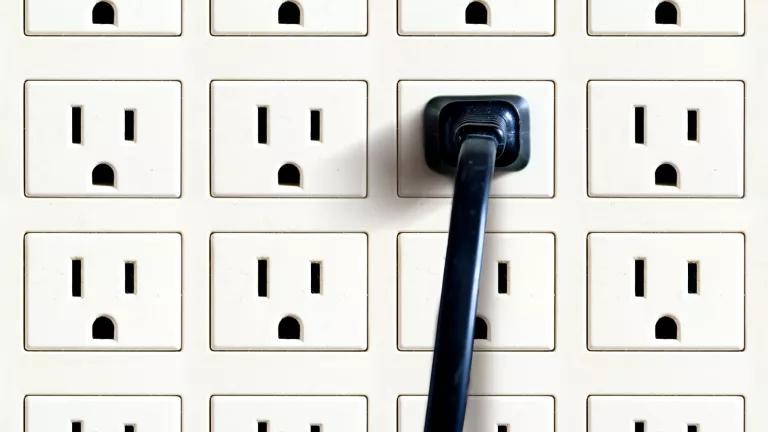Energy Vampires: Keep Your Devices from Wasting Energy and Money
Nearly one-quarter of home energy use is consumed by "vampires." Who can save us?

Imagine your home at its most peaceful. The television and stereo are off. You and your computing devices are in blissful slumber. The dishes are clean and dry, and the laundry is done for the week. Everything is still, except for one thing: the electricity meter. It’s spinning like mad. You are the victim of energy vampires—devices and appliances that continuously suck up electricity, even when switched off.
A 2015 NRDC study shows that “idle load electricity”—computers in sleep mode, digital video recorders, even certain kinds of electrical outlets—account for 23 percent of power consumption in the average household and represent roughly a quarter of your electricity bill, paid for no good reason.
That’s a big number on its own, but the trend is even more troubling. Although we’ve known about the problem for years, idle load consumption continues to increase, partly spurred by the proliferating bells and whistles on modern appliances. Previous studies have estimated that it represents 10, or at most 20, percent of home-energy use.
Indeed, it’s hard to pin much of the blame on consumers, when industry retains the power to make more efficient devices. And the government could also step up—for example, at virtually no cost to taxpayers and consumers, it could require appliance manufacturers to list the idle load consumption of devices on the label, or revise building codes to minimize the electricity consumption of furnaces, water heaters, garage doors, and even doorbells. Still—in addition to holding industry and government to account—there are several things you can do right now to fight energy vampires in your home.
Read labels before you buy new equipment.
Always buy appliances, equipment, and electronics with the Energy Star label to ensure you are buying one of the more energy-efficient models on the market. And unless you plan to plug a device into the wall before each use and unplug it after, avoid buying new devices that don’t have simple on–off switches (lacking in some heated-towel racks, for example).
Get a power strip.
Speakers, TVs, and other entertainment gadgets consume electricity when you’re not using them. Plug them into a power strip, and you can flip them all on or off in a split second.
Use timers.
Plugging devices into timers will save you from having to remember to turn things on and off. This works particularly well with items you only use at specific times, like coffee makers or heated towel racks. Devices like computers have built-in timers that can power down the machine automatically. Use them aggressively.
Activate a few power-saving settings.
On a new TV, select the “home” or “standard” mode when setting up the device. The “vivid” or “retail” options will make your TV overly bright and consume excess power. On your computer, monitor, or game console, disable the screensaver and turn on the auto power down option (if available). Also turn off the “quick start” or “instant-on” option. It’s nice that your TV or video game console can spring into action in a few seconds, but the energy grid pays dearly for that service.
Ditch your old set-top box and DVR.
You can stream programming directly via an app on your smart TV or through a low power–consuming streaming device like Apple TV or Roku stick instead. If you prefer to keep your set-top boxes and DVRs, call your cable, satellite, or telephone company and ask to update your setup with new IP-based equipment, which is more up to date and environmentally friendly.
Buy a power meter or have your utility provider install a smart meter.
Knowledge is power—or, in this case, saves power. These cheap and simple gadgets can tell you how much energy a device is using when sitting idle, which gives you the option of changing your behavior. Alternatively, smart meters measure electricity consumption in small intervals and can tell you how much energy you’re using when everything appears to be turned off.
Talk to your friends and family about this problem.
Many conservation topics are a drag, because there’s little the average person can do on their own to save the whales or stop deforestation in the Amazon. Idle load electricity consumption isn’t like that. All you have to do is throw a few switches. Suddenly, you’re part of the solution.
This NRDC.org story is available for online republication by news media outlets or nonprofits under these conditions: The writer(s) must be credited with a byline; you must note prominently that the story was originally published by NRDC.org and link to the original; the story cannot be edited (beyond simple things such as grammar); you can’t resell the story in any form or grant republishing rights to other outlets; you can’t republish our material wholesale or automatically—you need to select stories individually; you can’t republish the photos or graphics on our site without specific permission; you should drop us a note to let us know when you’ve used one of our stories.

What’s the Most Energy-Efficient Water Heater?
How to Ditch the Biggest Fossil Fuel Offenders in Your Life
How You Can Stop Global Warming